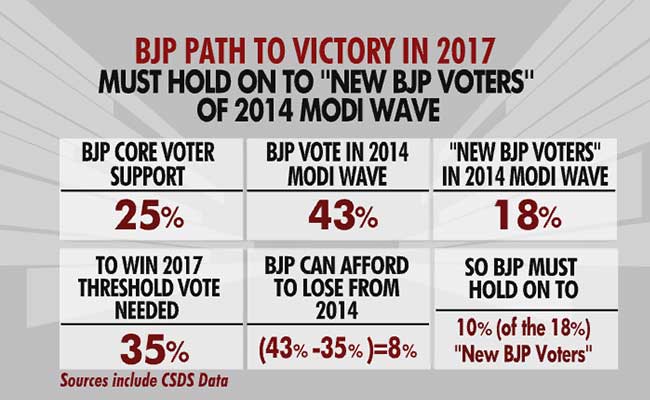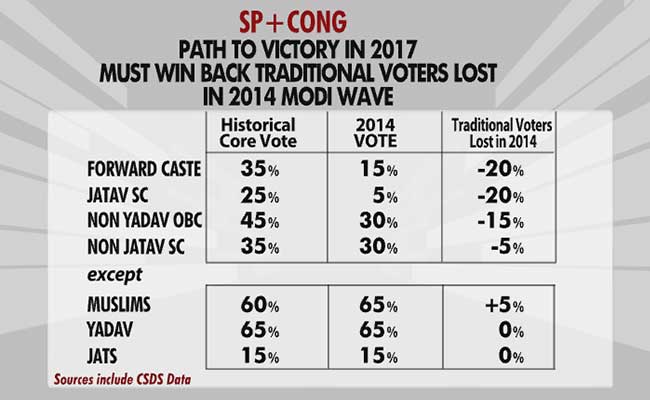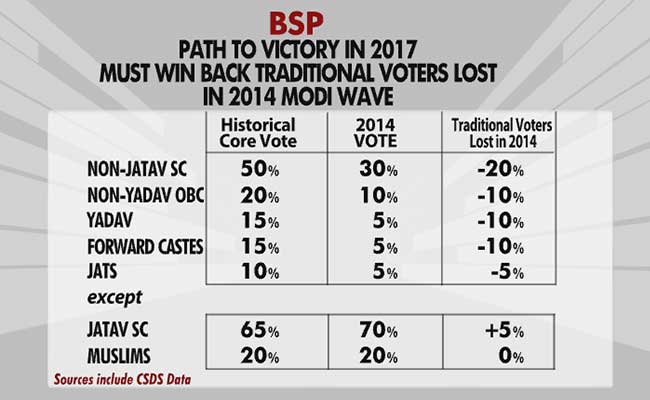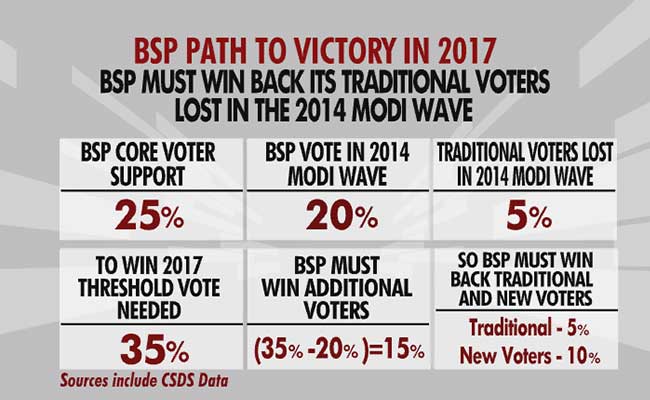Uttar Pradesh elections are being held in seven phases and counting will take place on March 11.
Quick Take
Summary is AI generated, newsroom reviewed.
BJP has to retain 10% of voters it picked up with Modi Wave
Alliance has to win back 5% of core supporters who left in 2014
Mayawati has to gain 10% new voters and regain 5% of core base
Just two years later, the unbeatable campaign dispensed by Narendra Modi, then a Prime Ministerial candidate, won his party the equivalent of 337 seats - a quantum leap of outstanding proportion.
In contrast, the Samajwadi Party, which had won 226 seats under the stewardship of Akhilesh Yadav in 2012, went into free fall to get 42 seats.
To win Uttar Pradesh (it has 403 seats), a party must get 202 seats or 35 per cent of the vote share. If you look at the general election results, the SP has 42 seats - less than 30 per cent.
The BJP had 337 seats or about 43 per cent. In 2012, it had barely 15 per cent.
To win power, the BJP must hold onto most of the "new voters" that it corralled with the storied Modi Wave of 2014.
Here's why. The BJP's core support group gives in 25 per cent of the vote. That shot up, as described earlier, to 43 per cent in the general election. So the gain from the Modi wave was 18 per cent. And to win, the minimum it needs is 35 per cent. So this time around, the party can afford to lose 8 per cent. Which means, it has to, at a minimum, retain 10 per cent of the "new BJP voters" it landed in 2014. Confused? Take a look at this graphic.

The Samajwadi Party and the Congress, on the other hand, have 35 per cent of the vote as their core group. In 2014, wiped out by the Modi wave, that share fell to nearly 30 per cent. Remember, to stay in the running, you need at least 35 per cent of the vote. So for the alliance to win this time, it must win back some of the voters it lost to the BJP in 2014. The core groups that deserted it in the biggest numbers were the forward castes and the Jatav Dalits. The Yadavs did not ditch the SP in 2014, and the Muslim support of the alliance grew by 5 per cent at the time (as a backlash to the Modi wave, Muslims consolidated for the SP and Congress).

So here's the math. The core support for the alliance is 35 per cent, which, in 2014, dropped to 30 per cent. So it lost 5 per cent of its traditional voters. To win, at least 35 per cent is needed - so the alliance must win back all 5 per cent that moved away from it in the general election.

Finally, Mayawati. In 2014, she got about 20 per cent of the vote. Her main supporters - the Jatav Dalits - stayed with her, just as the Yadavs remained with the SP despite the Modi wave. But she lost large chunks of Non-Jatav Dalits, the forward casts, and non-Yadav OBCs to the BJP.

Her core support group is 25 per cent of the vote. It fell to 20 per cent in 2014. The threshold for this election is 35 per cent. So she needs to gain 15 per cent: win back 5 per cent of her core group and add 10 per cent of new voters - a tougher ask than what her rivals face.

Track Latest News Live on NDTV.com and get news updates from India and around the world

